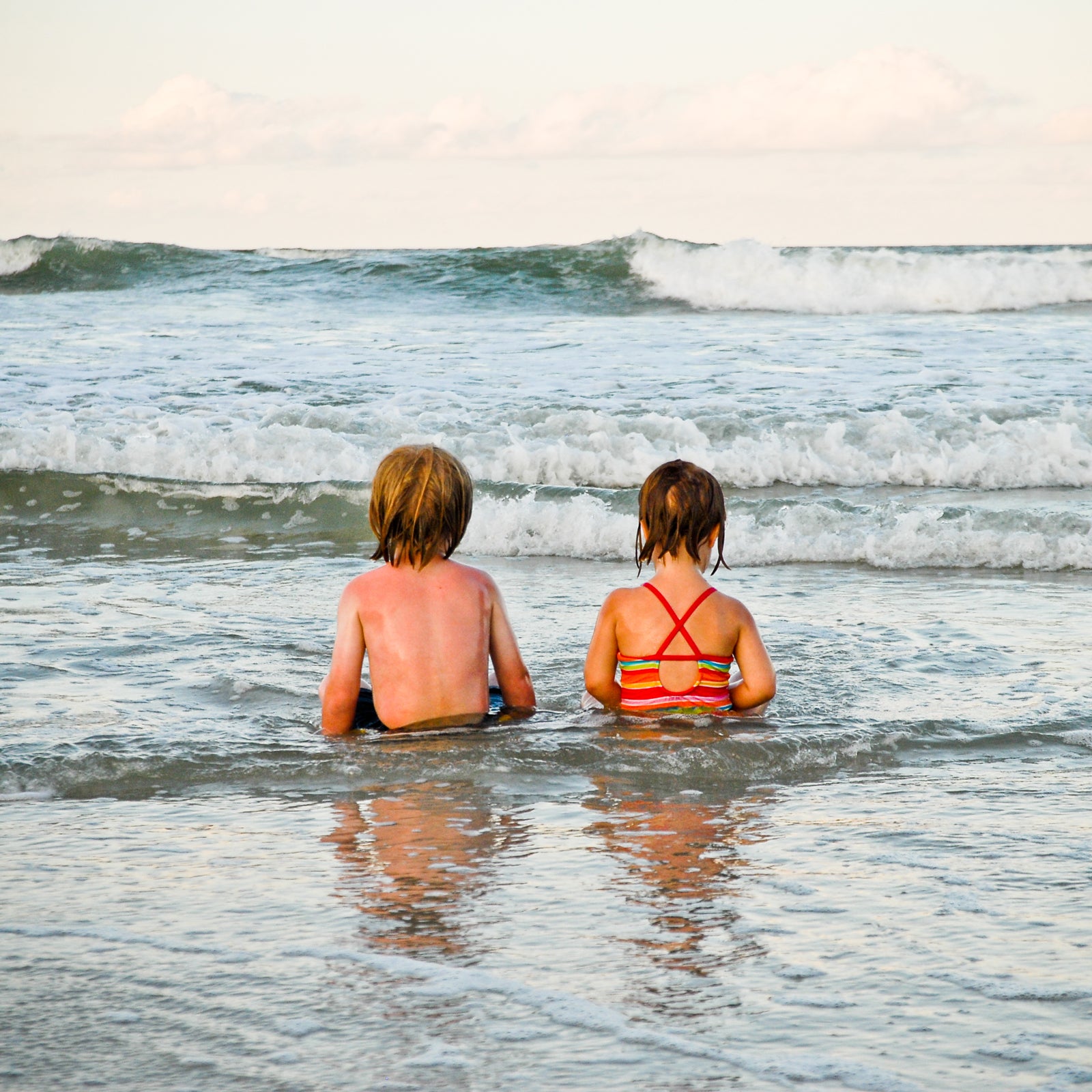My kids can’t swim. It’s ironic, really, given that they were both , in an inflatable bathtub in our living room, and they’ve spent their childhoods splashing in mountain creeks, tossing stones into lakes, and rafting down rivers. But however much they enjoy water, they’re out of their element in it. And nowhere is this more apparent—or more dangerous—than in the ocean.
My wife and I discovered this last month when we flew to Cancún, Mexico, for a friend’s wedding and some R&R along the Mayan Riviera. On the first day, our two boys, Theo (age five) and Julian (two), ran toward the ocean like it was a long-lost friend. The day was beautiful and windless, and I waded out with them into a sea��that was calm, flat, and��indeed,��very friendly. In the deeper water, Theo discovered that if he wiggled all of his body at once, he could keep his smiling face above the waves. He called it a “giggle swim.” Sheer joy was making him buoyant.
But joy is an unreliable flotation device. A week later, we drove down to Tulum, where three-foot waves battered the beach. As I was smearing sunscreen on my shoulders, I watched Theo skip out into the whitewater with a plastic bucket. Immediately, a wave slapped him in the face and knocked him down. He sat in the foam, coughing up salt water and wiping the sea from his eyes��while the receding waves pulled at his ankles. I raced over and scooped him up before the next wave broke. Suddenly, the��swirling, opaque water��felt more like a monster than a friend.
The ocean, of course, is neither friend nor monster—it’s liquid indifference. Just like mountains, the sea can teach us important lessons about our own cosmic insignificance. One day my children will learn these lessons. But in the meantime, when the waves were buffeting my boys and clawing at their toes, it seemed safer to avoid the ocean than try to understand it.
So when we got back to Montana, I called up Richard Schmidt, the Californian big-wave surfer who runs the popular in Santa Cruz. Schmidt raised his two boys, now 21 and 18, in the water. At age two, Schmidt’s oldest son, Richie, was catching waves on the front of his father’s surfboard. (Richie is now a world-class surfer, so the bug obviously caught.) His youngest son, Makai, took more time to be comfortable in the water, but now he’s an excellent surfer, too. His boys took swimming classes in a pool, but Schmidt made sure they knew the ocean was a different creature altogether.
“You need to really make it clear to kids that you have to be careful with the ocean,” Schmidt told me. “A swimming pool stays the same every day. The ocean changes.”
Schmidt suggested a few ground rules to help parents safely introduce their children to wilder waters.
Watch the Ocean
Just as fools rush in where angels fear to tread, children often feel a little too confident about dashing into the sea. “Never go into the ocean until you’ve watched it for a good 15 minutes,” Schmidt advises. Even when the waves are big, the ocean can appear calm between sets. “Some people jump right in, thinking it’s docile,” Schmidt says. “The next thing you know, you’re getting pounded.”
Instead, do a thorough job of checking out both the water and the beach��with your children. Are there lifeguards? Are there red flags? How are other people getting into the sea? Are there any rip currents? Rocks?
“Figure out what the ocean is doing,” Schmidt says. “Get a game plan, and imagine the worst-case scenario.”
And once you are ready to enter the water, make sure your kids know the fundamental rule of ocean safety: never turn your back on the sea.
Watch Your Kids
As I learned in Mexico, keeping track of your offspring can be��hard��at the beach, especially when the surf gets rough.
“You can’t take your eyes off of them,” Schmidt says. “More worry is better than less worry, that’s for sure.”
Schmidt spent 15 summers as a lifeguard in Santa Cruz, and he remembers seeing a four-year-old boy go under in the San Lorenzo River, which empties into the ocean in the heart of town. “I saw the kid go down,” says Schmidt, who raced to save him. “I’ll never forget looking down through the water at that little guy standing on the bottom, looking up at me. I pulled him up and found his parents, who were sunbathing.”��
When you take your children to the beach, their safety is paramount, but remember that you’re also establishing relationship with the ocean. Schmidt has seen surfer parents try to introduce their kids to waves��too quickly, only to unnecessarily traumatize them.��
“You’ve got to be careful with your kids in their early days,” Schmidt says. “If they get trounced by a wave when they’re young, they might reject the ocean and hold that fear forever.”
Pick the Right Beach��
Set your children up for success by carefully selecting a beach that will make their introduction to the ocean really positive. The perfect spot for young kids should be sandy, with a gentle slope into the water, and no rocks or tricky currents. “You want to be able to wade out for ten yards and it’s still knee-deep,” Schmidt says. “You don’t want drop-offs, where kids can fall into holes and the water’s over their heads.”
Look for these spots in protected places like coves. If you don’t know the area, find a surf shop and ask them about a child-friendly beach. Put a life jacket on your kids for a little extra security. And even before you head out to the beach, it’s wise to do some homework on the conditions. and the offer information on swell heights and intervals, the tide schedule, and wind conditions that will help you get the timing right.
My family and I found our happy place by accident, just north of Tulum, in Akumal, where we paddled around in what felt like a giant turquoise-colored bath while pods of bonefish nosed the sand at our feet. Someone told us there were loggerhead turtles out a little deeper. But we were having too much fun lolling around in the shallows to investigate.
Tell Your Kids Stories ������
Keeping young children safe in the waves can be stressful for a parent. One way to preempt this is by telling your children stories about the ocean. Inuit parents instill caution in their kids by telling them about a monster in the ocean that will rise up out of the waves, put them in a big pouch, and drag them down into the water if they get too close. Stories like this help young children learn to be careful around the ocean��and save their parents from anxious yelling on the beach. Of course, you don’t want to terrify your kids so much that they won’t even get wet, just enough to ensure a healthy respect of the ocean.
The stories needn’t always be folklore, either. Tell your children about times that you were afraid in the ocean. What did you do wrong? How did you get help? What did you learn? Important safety lessons are often more effective when they’re told as a story rather than a scolding.
Keep It Fun
If you want your children to grow up with respect and affection for the ocean, it’s important that their experiences around it are as positive as possible. The best times I had in the waves with my kids were��when I carried Theo or Julian out to where I could stand but they couldn’t. I’d hold them by the arms, and we’d face the incoming swell��together. As a wave rolled in, I’d lift my son’s head over the crest at the last minute. He was safe, I was relaxed, and we were both having fun.
But when the surf picks up and you tire of hovering over your kids in the breakers, shift gears and hit the sand. There are endless things to do on a beach that don’t involve a risk of drowning. Walk over to rocky points and look for tide pools. Start a seashell collection. Bring some toy dump trucks and excavators to dig holes and tunnels, and build castles. Kids don’t need much guidance for that kind of play. They’re hardwired for it. But they’ll almost always appreciate your companionship.


